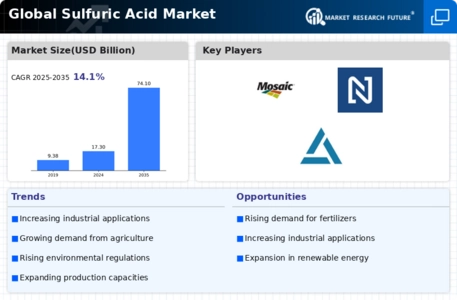Top Industry Leaders in the Sulfuric Acid Market
 Sulfuric acid, the king of industrial chemicals, reigns supreme with its diverse applications in fertilizer production, metal refining, water treatment, and countless other vital processes. the sulfuric acid arena is a cauldron of intense competition, boiling with innovation and strategic maneuvering.
Sulfuric acid, the king of industrial chemicals, reigns supreme with its diverse applications in fertilizer production, metal refining, water treatment, and countless other vital processes. the sulfuric acid arena is a cauldron of intense competition, boiling with innovation and strategic maneuvering.
The Titans and their Power Plays:
The Chemical Giants: Global behemoths like BASF, Chemtrade Logistics, and OCP (Office Chérifien des Phosphates) wield immense power through their vast production capacities, established supply chains, and diverse product portfolios. BASF's strong presence in both sulfuric acid production and fertilizer manufacturing solidifies its market dominance.
The Regional Champions: Companies like Yunnan Jihua Chemical Group and Gujarat State Fertilizers Corporation hold sway in specific regions due to their local networks, regulatory knowledge, and proximity to resource-rich areas. Yunnan Jihua caters to the booming sulfuric acid demand in China, while Gujarat State Fertilizers fuels India's agricultural sector.
The Specialty Players: Niche players like Epsilon Chemicals and Ozark Chemical excel in producing high-purity sulfuric acid for specialized applications like electronics and pharmaceuticals. Epsilon Chemicals caters to the stringent requirements of semiconductor fabrication, while Ozark Chemical supplies high-purity acid for pharmaceutical production.
Strategies that Sizzle and Solidify:
-
Cost Optimization: Optimizing production processes, utilizing by-products, and leveraging economies of scale are crucial for cost leadership. OCP's integration with phosphate rock mining allows for efficient sulfuric acid production and cost management.
-
Diversification: Offering a range of sulfuric acid grades and catering to diverse industries mitigates risks and expands market reach. Chemtrade Logistics supplies various acid concentrations and caters to sectors like metal, water treatment, and textile industries.
-
Technological Upgrades: Investing in cleaner production technologies, energy-efficient processes, and waste reduction strategies attracts environmentally conscious customers and regulatory compliance. BASF's focus on advanced emission control systems exemplifies this trend.
-
Regional Expansion: Entering new markets with high demand or untapped potential can fuel growth. Yunnan Jihua's expansion into Southeast Asia targets the region's burgeoning fertilizers and chemicals markets.
-
Partnerships and Acquisitions: Strategic collaborations and acquisitions can expedite market share gains and access new technologies. Gujarat State Fertilizers' partnership with a leading engineering firm aims to optimize its production facilities and improve efficiency.
Factors Dictating Market Share Champions:
-
Fertilizer Boom: Rising global population and increased food security concerns drive the demand for fertilizers, consequently boosting sulfuric acid consumption. OCP's strong positioning in the North African fertilizer market positions it to benefit from this trend.
-
Industrial Expansion: Growth in industries like metal processing, water treatment, and electronics fuels sulfuric acid demand in diverse sectors. BASF's diverse sulfuric acid offerings and global reach make it well-positioned to capitalize on this trend.
-
Environmental Regulations: Stringent emission control regulations and the push for cleaner production technologies create opportunities for companies with advanced production processes and waste reduction strategies. Epsilon Chemicals' high-purity sulfuric acid production with minimal environmental impact positions it to benefit from this shift.
Key Companies in the Sulfuric Acid Market includes.
-
BASF SE (Germany)
- OCP Group S.A. (Morocco)
- The Mosaic Company (US)
- Nouryon (Netherland)
- PVS Chemicals Inc (US)
- Aurubis (Germany)
- Ineos Enterprises Limited (UK)
- Oriental Carbon & Chemicals Ltd. (India)
- Amal Ltd. (India)
- Dexo Fine Chem Pvt. Ltd. (India)
Recent Developments:
-
September 2023: Glencore, a major sulfur producer, announced plans to expand production capacity in Australia, potentially easing future supply concerns. -
October 2023: Fertilizer demand, a major driver for sulfuric acid consumption, softened in some regions due to high fertilizer prices and weather uncertainties. -
December 2023: Several sulfuric acid plant expansions and restarts were announced in China, India, and Southeast Asia, indicating potential future supply increases.









